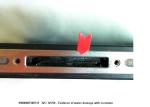How Can My iPhone Have Liquid Damage If The Sensor Wasn’t Tripped?

Verizon’s picture of the alleged liquid damage.
I read with great interest the article from Laura Northrup “How I Got Verizon To Credit Me $300 And Admit My Phone Had No Water Damage” dated Oct 26. I sent back an IPhone 4S about 6 weeks ago because the text message app would not play a sound when a text was received. No other app had a problem. Not long afterward received an email purporting to show that the phone had water damage. As it turned out there was no photo attached and I called Verizon. At length I explained that the phone had never been exposed to water and that I had examined the phone before sending it out as the return directions specify that one should look for the Liquid Contact Indicator. Neither indicator associated with the iPhone 4S was flipped. I had also brought the phone into a Verizon store to see if they could figure something out and they said that it should be returned. They did not notice any water damage. After awhile the customer service tech said that she would do an investigation and get back to me within 3 days. I never received any communication and assumed that Verizon had discovered their error.
The other day I received a disconnect notice and when informed of how much I owed it was immediately apparent that they had imposed the $299 charge. Another lengthy conversation with customer service ensued and this time I did get a photograph. Looking at it I can have no clue if the blobby image is indeed water damage and corrosion as they say. As mentioned in the article I also have no clue if it’s my phone, if it was dunked in water in transit, or what I’m looking at. I most definitely can see that the liquid contact indicator is not flipped.
Not to be too conspiratorial about it nonetheless it does make me wonder if there’s something going on with Verizon and if there are any more incidents like this out there. If nothing else it makes me wonder why Apple would bother with the LCI if, as Verizon tells me, it would not flip and yet still have water damage.
Nothing is foolproof. You don’t need to drop a phone in liquid to get corrosion, and just taking your phone on a run on a humid day might trip those sensors. Like Justin, Jeff should try gathering up some executive e-mail addresses and contacting someone higher up on Verizon’s food chain. Maybe they can help him.
It’s a good idea to photograph your electronics before sending them in: yes, it’s your digital image against the company’s, but better than having no proof at all that your phone wasn’t damaged when you sent it in.
Want more consumer news? Visit our parent organization, Consumer Reports, for the latest on scams, recalls, and other consumer issues.


